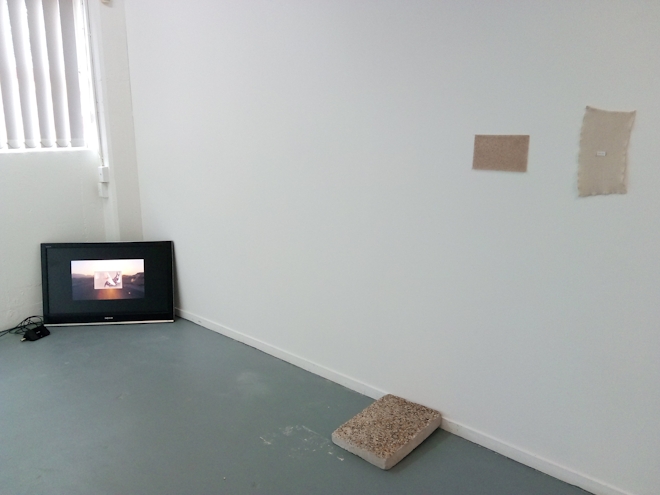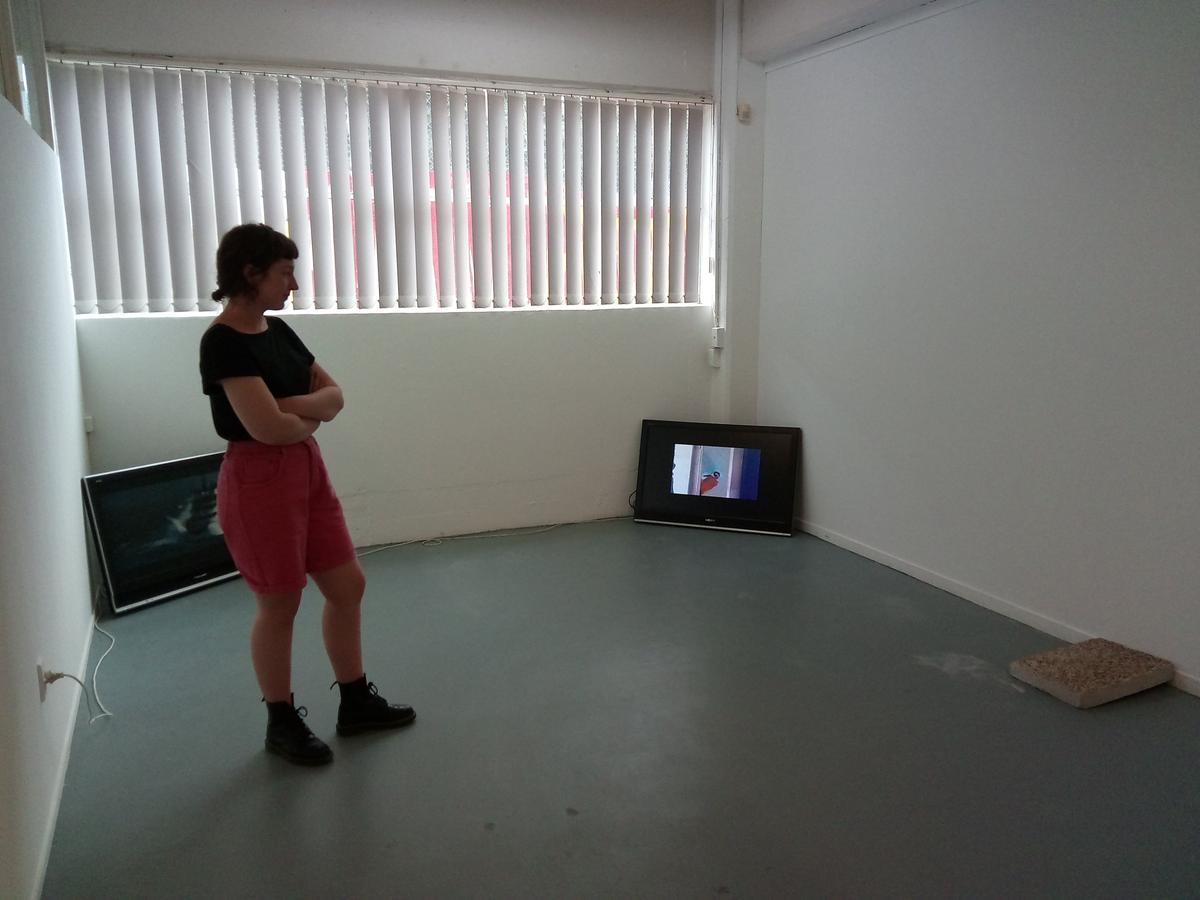The Pulse is an operational force that is both liberating and threatening. Everyday and every second of our lives we absorb it both consciously and subconsciously. It is inside of us and all around us. It is a paradox, keeping us alive and functioning, intimate and safe, and yet it can simultaneously feel claustrophobic and invasive.
PULSE/REPEAT is an exhibition presented at the Audio Foundation that explores ideas surrounding the Pulse. The artists featured include Alexandre Larose, Willow McCarthy, Magdalena Hoult, Diva Blair and Robyn Jordaan. Shared between them are themes of the body and the mechanical; with the pulse as mediating force.
In daily life we engage in pulse cycles both abject and technological. Walking through Wellington’s Cuba St or Auckland’s K Rd at night, I feel the rush of cars, while strobe lights from clubs blasting various different colours in time to the loud music from within. I can feel the bass rattle my body. Hearts racing, bodies moving with each other. Voices yelling, whispering, screaming, singing, talking, all blur into a humming, rhythmic sound. The next morning, we get up, go to work, check our Facebook feed, eat, and sleep. We repeat this; it is a pulse, a repetition. The ticking of our bodies, breathing, heartbeats, a pulse. We depend on the exhale after the inhale. We repeat this for our entire existence.
The Audio Foundation embodies a pulse in itself as a venue that supports the visual and audio arts. People move in and out through the space, keeping it alive, filling it with a pulse. The various cords, wires and technological equipment, forming beats, rhythms, patterns and sounds. Both bodily and technologically The Audio Foundation is pulsating.

Installation shot: St Bathans Repetitions (2016), Alexandre Larose
Alexandre Larose’s St Bathans Repetitions (2016) was filmed around the small Otago settlement of St Bathans. Never having visited the town previously, Larose’s choice of location was a deliberate attempt to distance himself from the hustle of the city or larger populated areas. Made as part of a 3-month residency undertaken with CIRCUIT in 2016-17 St Bathans Repetitions was shot on 16mm film. Crucial to the work is Larose’s choice of medium and the technique of repeatedly re-shooting the same scene, re-exposing the same filmstrip. The effect is a textural layering, suggesting material time.
The effect of cinema’s invention was to stop time. Creating an uninterrupted flow of movement drawn from life, it re-presented the past as a sequence of still images. For installation in the gallery, St Bathans repetitions is projected onto a translucent sheet, the after-image on the gallery wall emphasizing and creating a physical, bodily nature to the work. It possesses a strong inherent being, a life. On one hand the images and domestic subject matter add a slow and contemplative dreaminess, reflective of the implied sleepiness of the remote, small town environment. It is human and familiar, feels safe and warm. At the same time, the noisy heartbeat of the filmic layering and flickering, the technological repetition and reflection add an eerie otherworldly atmosphere to the work.
Alive and pulsing, both abject and mechanical, St Bathans repetitions is a mediation of both the physical body and the technological. The physicality of the subject matter and the tactile, process of the filmic medium that Larose choses to use interweave with each other, there is a relationship between the two. As the artist himself frames it “The film strip is a body acquiring memory”.

Installation view of (left) Twins (2017) Magdalena Hoult, (right) Saying the same thing but differently (2016) Willow McCarthy
Willow McCarthy’s sculptural series Saying the same thing but differently (2016) draws on raw materials and gestures both static and solid. Her choice of mundane, everyday materials such as concrete evoke various different personal memories, individual to us all and yet shared; the feeling of our bare feet on a hot kiwi summer, the concrete warmed up from the sun, burning our feet. Falling over and grazing the bodies surface, the unforgiving material paring a layer of skin back to reveal blood, the body interacting with the abrasive, unforgiving surface. A concrete building or home, a place to feel safe within its strict confines.
Everyday our bodies interact with objects and artefacts, machines and appliances. They are haptic and sensory relationships. We form routines and repetitions with these items. The feeling of bare feet on carpet, the texture of the wool, putting the soft bread into the toaster, reading the newspaper, fingers clutching onto the delicate paper to not tear it. McCarthy asks the viewer to form and reflect upon their own relationship with materials, one that exists outside of words, a felt memory. These works beckon towards an object-based ontology and ask the viewer to ponder the everyday bodily relationships they have with everyday materials, and the performances we undertake with them unconsciously. This work adds a bodily, haptic texture to the show. Magdalena Hoult’s video Twins (2016) rich imagery evokes a strong sense of sentimentality/nostalgia. As in David Lynch’s Eraserhead (1977), Hoult’s work begins with the ticking of a music box, as if signalling an entrance, a beginning. Twins is constructed as a montage of events, memories and experiences drawn from digital media. Exploring both the human pulse and the pulse of the entertainment world, Twins utilises both reality and fiction.
There is a tactility to Hoult’s choice of images, touching, holding, the feeling of fabric rubbing gently against skin, manipulating sand with a finger, close and intimate. Paired alongside the personal, haptic imagery there are more staged, artificial footage. This adds a frightening touch, creating an uncanny paradox, evoking a sense of fear combined with comfort of the familiar.

Still: Emotion Incarnate (2016), Diva Blair
It has often been said that we have a somewhat erotic relationship with technology and machines. Our bodies touch, caress and hold various different devices on a daily basis. It is intimate and tactile. Our cellphones are almost always beside our skin, they even come to bed with us. The way that we imply gender to material objects is embedded in everyday language - “she’s a beauty” when referring to a car or a boat.
The ocean is a large body of water, it is organic, fluid, unpredictable and unstable like the human body. Waves rise and fall and crash, like a chest breathing in and out, inhale, exhale. Diva Blair’s work Emotion Incarnate (2016) evokes these sensations. The large ship crashes over the waves. The rigid metal penetrating the fluid substance. An inhale and exhale as the female voice sensually speaks to the viewer of her erotic desires. The machine/ship aggressively forces it’s way through the water, a movement that it is simultaneously satisfying, humorous and inherently sexual. Through the use of filmic tropes and the visual contrast between the rigid metal and fluid water, the artist alludes to a sexual relationship between the machine and the human. And perhaps, through our daily use of machines, we already have an erotic relationship with them that we are unaware of.
The opening night featured a live performance by Robyn Jordaan. This work involved the artist walking through a labyrinth of plated hair, 48 meters to be precise. Wrapping the hair around their naked body as they approached the objects, there was a sensitivity, a tenderness towards the large, Familiar, beautiful objects. Jordaan then began to engage with the audience, asking us to pick a number. They then proceeded to read a chapter from a book, corresponding with the number that the audience member chose. This work encourages and explores thought surrounding gestures and exchange, the body and bodily participation. Everyday we breathe, sweat, move, stretch and our ticking bodies keep going. The technological Pulse is everywhere; it is almost as inescapable to avoid the flashing lights as it is to escape our fallible, abject bodies. PULSE/ REPEAT explores the negotiation and mediation between both the bodily and technological Pulse cycles. The Pulse is a paradox, both liberating and threatening, a condition of our being.
